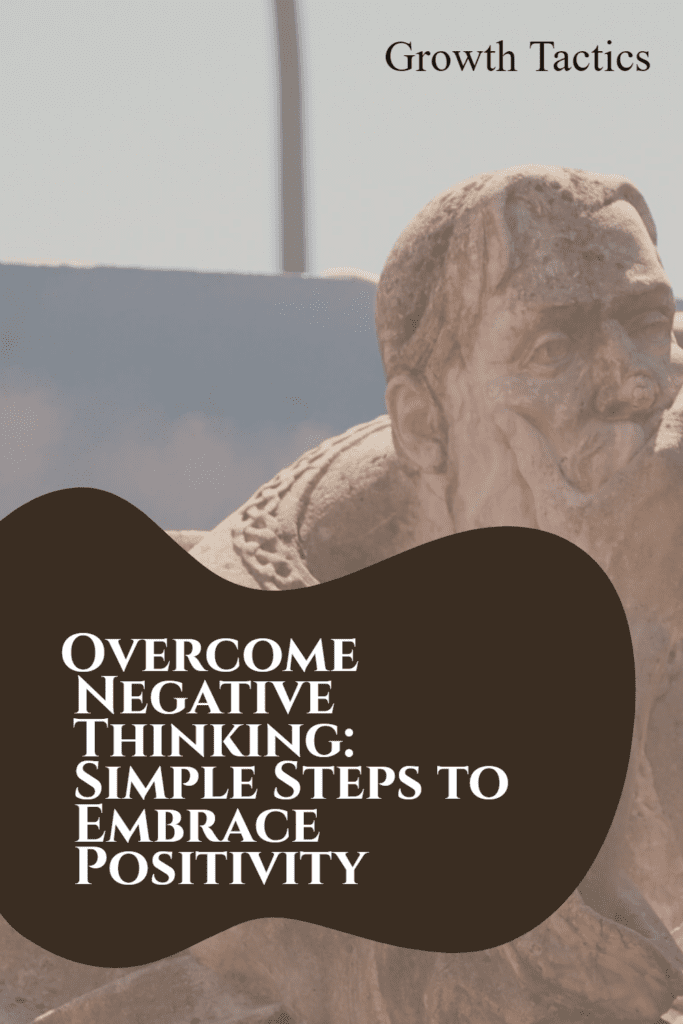Negative thinking can have a significant impact on our overall well-being and quality of life. It can cloud our judgment, hinder our progress, and create unnecessary stress and anxiety. The good news is that with a little effort and a shift in mindset, we can overcome negative thinking and embrace the power of positivity.
In this article, we will explore effective strategies to overcome negative thinking and develop a more positive outlook on life.
Jump To Section
Understanding Negative Thinking
Before we dive into the steps to stop negative thoughts, let’s take a moment to understand what it entails. Negative thinking refers to a pattern of thoughts that predominantly focuses on the downside of situations, ourselves, or others.
It involves constantly dwelling on failures, anticipating the worst outcomes, and engaging in self-deprecating self-talk.
Different Types of Negative Thinking Patterns
Negative thinking can manifest in various forms, and understanding the different types of negative thinking patterns can help us tackle them more effectively. In this section, we will delve into the specific patterns that negative thinking can take, shedding light on how they can impact our lives.
1. Catastrophizing
When we engage in catastrophizing, we have a tendency to blow things out of proportion, expecting the absolute worst outcome in any given situation. It’s like our minds instantly jump to the worst-case scenario, magnifying the negative aspects and downplaying any potentially positive outcomes.
For example, if we make a small mistake at work, we might convince ourselves that we will get fired and lose everything.
2. All-or-Nothing Thinking
In all-or-nothing thinking, we see things in extremes without considering the shades of grey in between. This type of thinking leaves no room for middle ground or flexibility.
We view situations as black or white, success or failure, with no acknowledgment of the complexities and nuances that exist. For instance, if we receive a small criticism, we might completely disregard all the positive feedback we have received and perceive ourselves as a total failure.
3. Personalization
With personalization, we tend to take things personally and internalize external events or circumstances. We assume that we are the cause of negative occurrences, even when they have nothing to do with us.
For example, if a friend cancels plans, we might assume that it’s because they don’t like us, rather than considering that they may have other commitments or reasons for canceling.
4. Overgeneralization
Overgeneralization involves making broad, sweeping generalizations based on a single negative experience. If one thing goes wrong, we assume that it’s an indication that everything will always go wrong.
For instance, if we fail at a job interview, we may conclude that we are destined to fail in all future interviews, disregarding the fact that each situation is unique and can yield different results.
5. Mind Reading
In this type of negative thinking pattern, we believe that we can accurately predict what others are thinking, even when we have no solid evidence to support our assumptions. We convince ourselves that we know exactly what people think about us or the judgments they are passing, leading to feelings of self-doubt and insecurity.
For instance, if someone doesn’t respond to our text message immediately, we may assume that they are angry or upset with us.
6. Filtering
When we engage in filtering, we selectively focus only on the negative aspects of a situation while completely disregarding any positive elements. We cherry-pick the negative details and filter out everything else, creating a distorted perception of reality.
For example, if we receive a performance review with mostly positive feedback and a single area for improvement, we might fixate solely on the criticism and discount the praise we received.
The Impact of Negative Thinking
Negative thinking has a profound impact on our overall well-being and the way we navigate through life. It seeps into our thoughts, emotions, and actions, influencing how we perceive ourselves, others, and the world around us.
In this section, we will explore the various ways in which negative thinking can shape our lives and the importance of breaking free from its grip.
Mental and Emotional Health
Negative thinking takes a toll on our mental and emotional well-being. When we constantly dwell on negative thoughts, it breeds feelings of self-doubt, worthlessness, and despair. It can lead to increased levels of anxiety, stress, and even depression.
Our perception becomes clouded, and we find it challenging to see the positives in our lives. The constant negativity creates a vicious cycle that is hard to break, ultimately affecting our mental and emotional health.
Relationships and Interactions
Negative thinking patterns can have a detrimental impact on our relationships and interactions with others. When we view the world through a negative lens, it colors our perception of people and situations. We may become more suspicious, judgmental, and defensive in our interactions.
Constant pessimism can repel others, leading to strained relationships and missed opportunities for connection and growth. Building and maintaining healthy relationships becomes an uphill battle when negative thinking dominates our mindset.
Productivity and Success
Negative thinking inhibits our ability to perform at our best and achieve our goals. When our minds are clouded with self-limiting beliefs and a constant focus on failures and shortcomings, it becomes difficult to muster the motivation and confidence needed to take risks or pursue new opportunities.
Productivity suffers as we get stuck in a loop of self-doubt and procrastination. Our chances for success diminish as negative thinking robs us of the belief in our own abilities and potential.
Physical Health
The impact of negative thinking extends beyond our mental and emotional well-being—it can also affect our physical health. Persistent negative thoughts create stress and anxiety, triggering a physiological response in our bodies.
This stress response can lead to increased blood pressure, compromised immune function, and even chronic health conditions over time. Negative thinking can contribute to poor lifestyle choices, such as neglecting exercise, overeating, or turning to unhealthy coping mechanisms, further compromising our physical well-being.
Steps to Stop Negative Thinking
Overcoming negative thinking requires self-awareness, practice, and a commitment to change. Let’s explore some simple steps that will help you break free from negative thinking patterns and cultivate a more positive mindset.
1. Recognize and Challenge Negative Thoughts
The first step in overcoming negative thinking is to become aware of the negative thoughts that arise in your mind. Notice when you start engaging in self-limiting beliefs or when you find yourself thinking negatively about a situation.
Once you identify these thoughts, challenge them. Ask yourself if there is any evidence supporting the negative thought or if it’s just a product of your imagination.
2. Replace Negative Thoughts with Positive Ones
Once you’ve recognized and challenged your negative thoughts, it’s time to replace them with positive ones. This may feel challenging at first, but with practice, it becomes easier.
When a negative thought arises, consciously replace it with a positive affirmation or a realistic, constructive thought. For example, if you find yourself thinking, “I’ll never succeed,” replace it with, “I am capable of achieving my goals with hard work and dedication.”
3. Practice Gratitude
Gratitude is a powerful tool in shifting our focus from negativity to positivity. Take a few moments each day to reflect on the things you are grateful for. It could be something as small as enjoying a good cup of coffee or as significant as having a supportive friend or family member.
By practicing gratitude, you train your mind to appreciate the positive aspects of your life and reframe your thoughts toward a more optimistic perspective.
4. Engage in Regular Meditation
Meditation is a practice that helps calm the mind, reduce stress, and promote a positive mindset. By setting aside a few minutes each day to meditate, you create a space for self-reflection and inner peace.
Focus on your breath, observe your thoughts without judgment, and let go of any negative emotions or beliefs that arise. With consistent practice, meditation can help rewire your brain, making it easier to let go of negative thinking patterns.
5. Surround Yourself with Positive Influences
The people we surround ourselves with can greatly influence our mindset. Seek out individuals who radiate positivity and inspire you to be your best self. Engage in conversations that uplift and motivate you.
Surrounding yourself with positive influences will help reinforce your commitment to overcoming negative thinking and maintaining a positive outlook.
Embrace the Power of Positive Thinking
Overcoming negative thinking is a journey that requires patience, consistency, and self-compassion. By recognizing and challenging negative thoughts, replacing them with positive ones, practicing gratitude, engaging in regular meditation, and surrounding yourself with positive influences, you can gradually shift your mindset and embrace the power of positive thinking.
Remember, change takes time, so be kind to yourself during this transformative process. As you persist in your efforts, you’ll discover the incredible impact that a positive mindset can have on your life.


